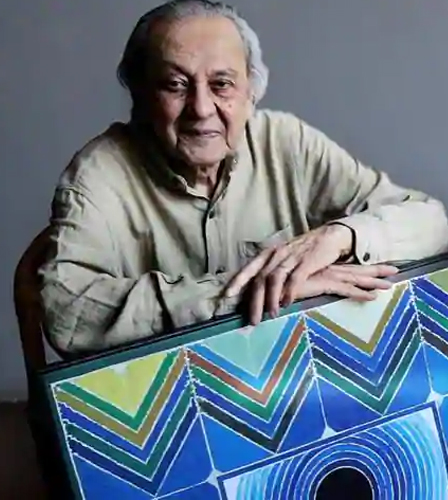About Raza

About RAZA
The Artist
Sayed Haider Raza was one of India’s most prolific first-generation post-independence artists who acquired global fame earning national and international honours such as the Padma Shri, Padma Bhushan, Padma Vibhushan and the Prix de la critique, an early decoration that was bestowed to him in 1956, making him the first non-French artist to receive the honour. The French government also conferred the Commandeur de la Legion d'Honneur, the highest French honour upon him in 2015.
His journey from being a small-town boy born in Babaria (Madhya Pradesh) in 1922 to being a pioneering force of the Modern Indian Art movement has been a splendid exposition of a series of events that eventually launched him on the global art circuit.
Timeline
History

1930
The Early Days
The artist’s nascent influences steeped in nature are evident in his canvas -- whether it is in his colour palette or in the natural symbols such as the moon that appeared in his earlier works, Raza was clearly carrying the images of his childhood spent in the midst of verdant forests in the recesses of his artistic memory. After completing his school education in Damoh (Madhya Pradesh), he enrolled himself at the Nagpur School of Art in 1939. On graduating from Nagpur, he took up a job as a drawing teacher at the Government School in Gondia and eventually set his sights on Bombay where he joined the famous J.J School of Arts in 1943.

1940
The Rebel
In Mumbai he met fellow artists like F N Souza and M F Husain and together they formed the Progressive Artists’ Group, a rebel movement in Indian art to challenge the artistic idiom endorsed by the Bengal School of Art. In 1948 during a visit to Kashmir, Raza met the French photographer Henri Cartier-Bresson who advised him to study Cezanne to be able to understand the construction of a painting. This meeting sparked a desire in Raza to go to France and observe Cezanne and the works of other masters.

1950
Moved to a new home
He moved to Paris in October 1950 to study at the École Nationale Supérieure des Beaux-Arts in Paris, (1950 - 1953) on a French scholarship. After his studies, he travelled across Europe and continued to live and exhibit his work in Paris. He married fellow artist Janine Mongillat in 1959, further strengthening his identity as a Francophile.

1960
The Bindu
S.H. Raza was slowly but steadily gaining fame. His works had already been showcased not only in France but also in the USA and Canada. He was invited by Professor Karl Casten to be a visiting lecturer at the University of California, Berkeley in the year 1962. During his time there, he visited various galleries in and around New York, and discovered an inclination towards the works of artists like Mark Rothko and Hans Hofmann. In fact, one could see the influence of abstract expressionism in his paintings after his brief sojourn in America. His works had finally made a major shift from representational to expressionist art. His yearning for home was at its peak around this time, and it was during his stay in Berkeley that he painted the first Rajasthan painting. Increasingly over the years, Raza had started growing restless in his artistic journey.
He felt that it lacked Bhava (emotion) and he wanted to bring back the aesthetics of the land in which he was born. Visiting his native place and going back to where it all began finally helped Raza arrive at the Bindu, the most discussed aspect of his works amongst his vast repertoire. Raza had found the perfect motif to channel his energies and bring everything into sync. With the Bindu, Raza’s quest came full circle. The Bindu was the perfect coming together of all the cultural elements and experiences he had amassed. “The Bindu is the symbol not only of Hindu spirituality but also of Indian art, aesthetics and awareness of life,†he had reflected.

Art & Science Events
He moved to Paris in October 1950 to study at the École Nationale Supérieure des Beaux-Arts in Paris, (1950 - 1953) on a French scholarship. After his studies, he travelled across Europe and continued to live and exhibit his work in Paris. He married fellow artist Janine Mongillat in 1959, further strengthening his identity as a Francophile.

2016
Art Gallery Showcasing
His return to India in the sunset of his life was a significant move that came after spending six decades in France, strongly suggesting that even while he accumulated global accolades, his heart and art truly belonged to India. He passed away in 2016, leaving behind a rich legacy of art that will remain unparalleled for posterity.


